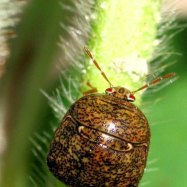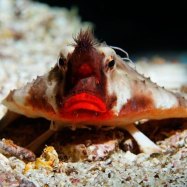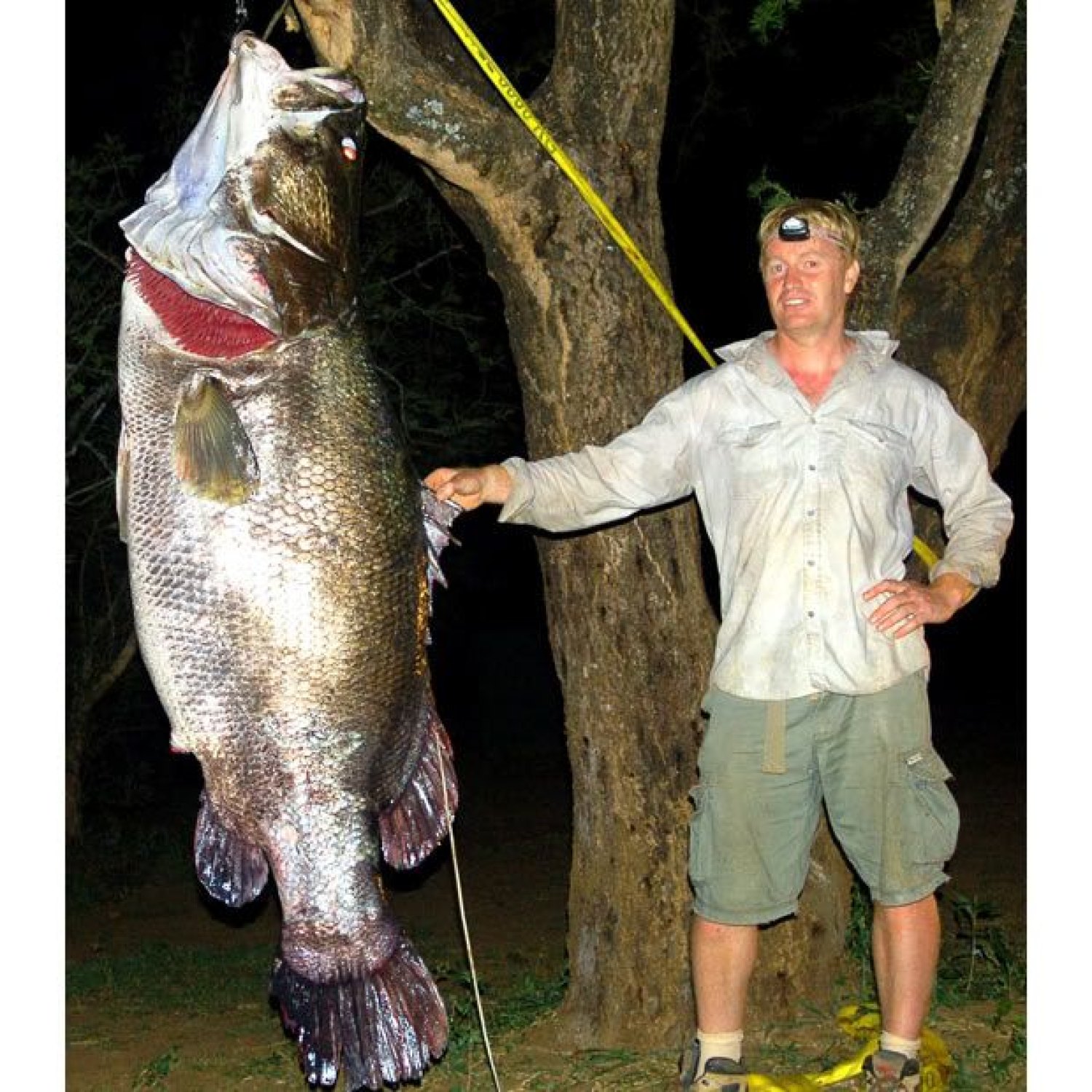
Nile Perch
Up to 6 feet
The Nile Perch, found in African lakes and rivers, is a large freshwater fish that can grow up to 6 feet in length. Belonging to the Latidae family, its elongated and streamlined body shape allows it to quickly dart through the water in search of prey. Keep an eye out for this impressive fish on your next trip to Africa! #NilePerch #AfricanWildlife #FreshwaterFish
Animal Details Summary:
Common Name: Nile Perch
Kingdom: Animalia
Habitat: Freshwater
The Mighty Nile Perch: Africa's Legendary Predator
Africa is a continent of mystery and magic, a place of remarkable landscapes, diverse cultures, and rich history. But it's also home to some of the most fascinating creatures on the planet. And among them, one stands out as Africa's legendary predator – the Nile Perch.The Basics
Scientifically known as Lates niloticus, the Nile Perch is a member of the Kingdom Animalia, belonging to the Phylum Chordata and Class Actinopterygii Nile Perch. It is part of the order Perciformes and the family Latidae. Found in freshwater habitats, this predatory fish is native to Africa, specifically the Nile River in Egypt.The Nile Perch is a large, elongated fish with a streamlined body shape, enabling it to move swiftly and silently in the water. It comes in shades of grey to silver, giving it a majestic appearance. Its size is also remarkable, reaching up to 6 feet in length. But its physical characteristics are not the only things that make this fish stand out.
Perfect Predator
The Nile Perch is known for its remarkable feeding abilities, making it one of Africa's top predators. With its sharp teeth and powerful jaws, it preys on a variety of aquatic creatures, including smaller fish, crustaceans, and even birds. This ability to hunt and consume a variety of prey makes it a key player in the ecological balance of freshwater environments New Hampshire Red Chicken.A closer look at the Nile Perch's feeding method reveals an interesting fact – it uses a highly advanced sensory system to locate its prey. This system is called "lateral line," and it allows the fish to detect even the slightest movements of other aquatic creatures, making it a ruthless and efficient predator.
Geographical Distribution
As mentioned earlier, the Nile Perch is native to Africa, specifically the Nile River. However, due to its popularity in sport fishing, the fish has been introduced to several lakes and rivers across the continent. It can now be found in many African countries, from Egypt to Uganda, and even as far as the Democratic Republic of Congo.Its introduction to new habitats has had both positive and negative impacts on the local ecosystems. The Nile Perch's ability to feed on smaller fish has led to a decline in certain species, causing ecological imbalances. On the other hand, it has also provided a new food source for local communities, supporting their livelihoods.
Fishing for the Nile Perch
The Nile Perch's popularity extends beyond its natural habitat. It has become a sought-after species for sport fishing, attracting anglers from all over the world. Its size, strength, and fight make it a challenging catch, providing an exhilarating experience for fishermen.However, the rise in demand for the Nile Perch has led to overfishing, causing concerns for its sustainability. In response, regulations and conservation efforts have been put in place to protect the fish's population. Sustainable fishing practices and catch limits have been enforced to ensure the species' survival.
Interesting Facts
Aside from its impressive physical and feeding abilities, the Nile Perch has many other interesting features worth mentioning.- The Nile Perch is the second-largest freshwater fish in Africa, with only the African catfish being larger.
- It has a unique ability to adapt to various environments, making it a highly invasive species.
- The Nile Perch can live for up to 20 years, with females growing much larger than males.
- It has a distinctive red spot on its tail, which is believed to act as a fake eye to confuse its predators.
Threats to the Nile Perch
Despite its strength and adaptability, the Nile Perch faces several threats that put its survival at risk. The main threat is overfishing, as mentioned earlier. The demand for the fish has led to unsustainable fishing practices and the depletion of its population in certain areas.Habitat destruction is another significant threat to the Nile Perch. As human populations expand, aquatic habitats are being destroyed, disrupting the fish's natural environment and affecting its reproductive cycle. Pollution also poses a threat, as it can contaminate the water and harm the Nile Perch and other aquatic species.
In Conclusion
The Nile Perch is a fascinating and powerful predator, representing the wild and mysterious side of Africa. Its presence in lakes and rivers across the continent has had both positive and negative impacts, highlighting the delicate balance of nature.As we continue to learn more about this majestic fish, it is essential to remember the importance of responsible and sustainable fishing and conservation efforts. Only then can we ensure the Nile Perch's survival and continue to marvel at its mighty presence in Africa's waters.

Nile Perch
Animal Details Nile Perch - Scientific Name: Lates niloticus
- Category: Animals N
- Scientific Name: Lates niloticus
- Common Name: Nile Perch
- Kingdom: Animalia
- Phylum: Chordata
- Class: Actinopterygii
- Order: Perciformes
- Family: Latidae
- Habitat: Freshwater
- Feeding Method: Predator
- Geographical Distribution: Africa
- Country of Origin: Nile River, Egypt
- Location: Lakes and rivers in Africa
- Animal Coloration: Grey to silver
- Body Shape: Elongated and streamlined
- Length: Up to 6 feet
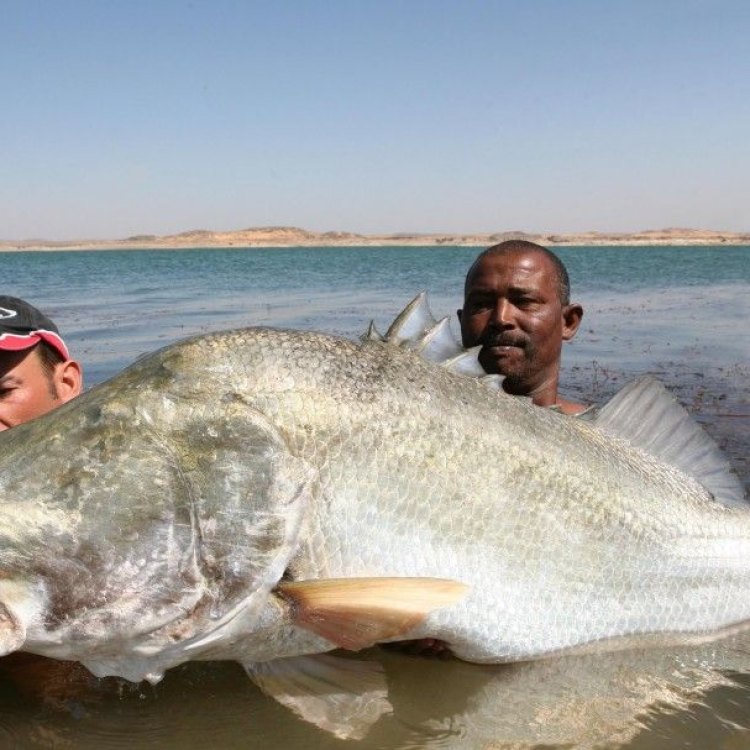
Nile Perch
- Adult Size: Up to 220 pounds
- Average Lifespan: 10-20 years
- Reproduction: Sexual
- Reproductive Behavior: Spawning
- Sound or Call: Not known to produce sounds
- Migration Pattern: No regular migration pattern
- Social Groups: Solitary
- Behavior: Aggressive and territorial
- Threats: Overfishing, habitat destruction
- Conservation Status: Least Concern
- Impact on Ecosystem: Can cause declines in native fish populations
- Human Use: Commercial and recreational fishing
- Distinctive Features: Large size and long dorsal fin
- Interesting Facts: One of the largest freshwater fish species in the world
- Predator: Other large predatory fish
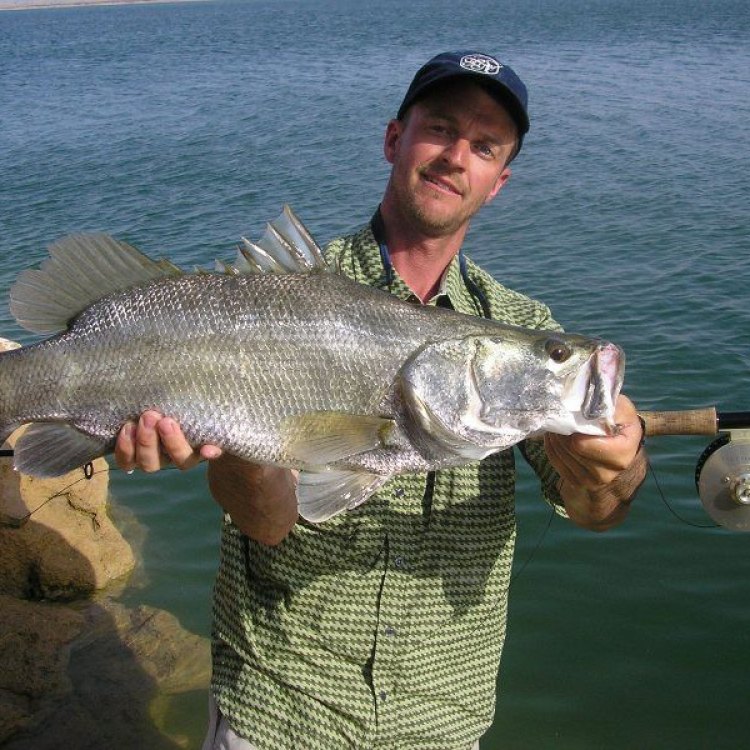
Lates niloticus
The Mighty Nile Perch: A Fascinating Creature of the Waters
The Nile Perch, scientifically known as Lates niloticus, is a massive fish species found in the freshwater lakes and rivers of Africa. As its name suggests, this fierce predator is native to the Nile River but is also found in other African river systems, including Lake Victoria, Lake Tanganyika, and Lake Turkana.The Nile Perch is an impressive fish, both in size and behavior, making it a subject of fascination among scientists and anglers alike. In this article, we will dive deep into the unique features and characteristics of this magnificent creature and learn about its impact on the ecosystem and the human population PeaceOfAnimals.Com.
Let's start by exploring its physical appearance and behavior traits.
The Giant of Freshwater: Size and Lifespan
The Nile Perch is one of the largest freshwater fish species in the world. It can reach an astounding weight of up to 220 pounds, with a length of over 6 feet. Considering its size and weight, it is no surprise that the Nile Perch is a dominant predator in its habitat.This massive fish species has an average lifespan of 10-20 years, with some individuals living up to 25 years in ideal conditions. Interestingly, the Nile Perch continues to grow throughout its life, with the females growing larger than the males.
Reproductive Behavior: Spawning in the Wild
The Nile Perch is a sexual species, where both male and female adults participate in the spawning process. They usually spawn in the shallow waters of their native habitat during the rainy season. The females scatter their eggs on the rocky bottom while the males fertilize them Netherland Dwarf Rabbit.Female Nile Perch can lay up to three million eggs in a single spawning season, ensuring that the species continues to thrive in the wild. However, there is a significant decline in their reproductive behavior due to overfishing and habitat destruction.
The Silent Hunter: Sound or Call
Unlike some fish species, the Nile Perch is not known to produce any sounds or calls. They use their keen sense of smell and sharp vision to capture their prey. Their proficiency in hunting is one of the factors contributing to their dominance in their ecosystem.A Nomadic Lifestyle: Migration Pattern
The Nile Perch does not have a regular migration pattern, unlike other fish species. They are non-migratory, staying close to their preferred habitat. However, they are known to move to deeper waters during the dry season, where the water is cooler and more suitable for their survival.King of Solitude: Social Groups and Behavior
The Nile Perch is a solitary creature, preferring to hunt and roam alone. They are aggressive and territorial, making it challenging for them to coexist with other fish species. They establish their territory in a particular area of their habitat, defending it fiercely from intruders.Their behavior and solitary nature also make it challenging to study their social groups, as they rarely interact with others of their kind.
Survival in Danger: Threats and Conservation Status
The Nile Perch faces significant threats to its survival, primarily caused by human activities. Overfishing is the primary threat to this species, and it has led to a rapid decline in their population. Other threats include habitat destruction, pollution, and the introduction of non-native species into their habitat.Despite these threats, the Nile Perch is currently listed as a species of Least Concern on the IUCN Red List. However, continuous monitoring and conservation efforts are crucial to ensure the survival of this magnificent creature.
The Unintended Consequence: Impact on Ecosystem
The Nile Perch has a significant impact on the ecosystem of its native habitat. As a top predator, it plays a crucial role in regulating the population of other fish species, maintaining the balance of the ecosystem. However, the introduction of this non-native species in some areas has caused a decline in the population of native fish species, leading to an ecological imbalance.Moreover, the Nile Perch's large size and aggressive nature make it a dominant predator, resulting in a decrease in diversity in fish populations. Scientists are continuously studying the long-term effects of the Nile Perch's presence in different ecosystems, highlighting the importance of mindful conservation practices.
Human Use: Commercial and Recreational Fishing
The Nile Perch's impressive size and delicious taste make it a highly sought-after species for commercial and recreational fishing. It is a significant source of income for many fishing communities in Africa, and it also serves as an attraction for anglers from around the world.However, the increased demand for this species has led to overfishing, making it a critical concern for its survival. Sustainable fishing practices and regulations are crucial to ensure that the Nile Perch is not commercially exploited beyond its population's ability to replenish.
Distinctive Features: The Markings of a Giant
One of the most striking features of the Nile Perch is its size and long, pointed dorsal fin, which gives it an intimidating appearance. They have a silvery-grey body with dark spots, making them camouflaged in the murky waters of their habitat. Their large mouth and sharp teeth are also notable features, essential for their predatory behavior.Did You Know?
- The Nile Perch is known to consume small crocodiles, leading to the myth that it could also feed on humans. However, there is no evidence of Nile Perch attacking humans in the wild.- Despite its name, the Nile Perch is not a perch but belongs to the Latidae family, which includes other predatory fish species like Barramundi and Hapuka.
- The Nile Perch has been introduced to other regions, including Papua New Guinea and Indonesia, for recreational fishing and aquaculture, leading to concerns about their impact on native fish populations in these areas.
Survival of the Fittest: Predator and Prey
The Nile Perch's large size and aggressive nature make it a formidable predator in its native habitat. But, like every creature in the wild, it also has its predators to worry about. Other large aquatic predators, including crocodiles and large catfish, are known to prey on the Nile Perch.With humans at the apex of the food chain, the Nile Perch's survival ultimately depends on sustainable and responsible fishing practices and conservation efforts.
In Conclusion
The Nile Perch is a fascinating creature, with its massive size, solitary behavior, and predatory nature. While it continues to mesmerize scientists and anglers with its unique features, its increasing population decline remains a significant concern.It is our responsibility to ensure the survival of this majestic species by promoting sustainable fishing practices and protecting their habitat. Let us appreciate the Nile Perch's presence in our ecosystem while also striving to preserve its existence for future generations to witness the might of this incredible creature.
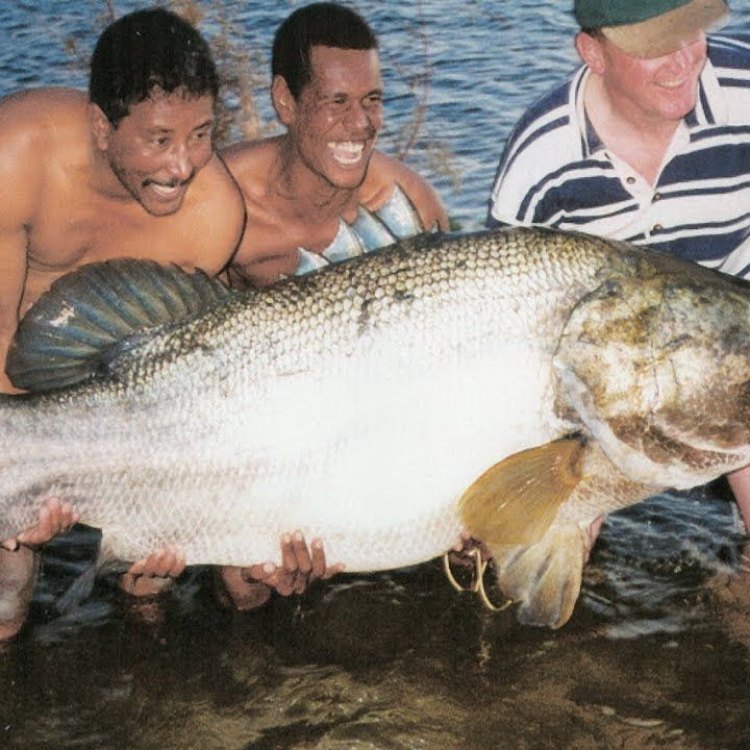
The Mighty Nile Perch: Africa's Legendary Predator
Disclaimer: The content provided is for informational purposes only. We cannot guarantee the accuracy of the information on this page 100%. All information provided here may change without prior notice.











